International Journal of Information Technology and Computer Science @ijitcs
Статьи журнала - International Journal of Information Technology and Computer Science
Все статьи: 1254
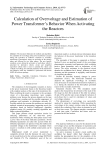
Статья научная
The document illustrates the methods and algorithms for calculation of overvoltage at the power transformer excerpts during the activation of inductive consumer to secondary transformer. Characteristic stages are activation of the primary phase and followed by two other phases. The new specific condition occurs during the activation of each phase which is presented by alternative electric circuit and simplified equivalent scheme that is used to calculate the values and evaluate overvoltage. For selected parameters of the transformer and inductive loads, the simulation is performed with chosen MATLAB software package.
Бесплатно
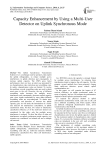
Capacity Enhancement by Using a Multi-User Detector on Uplink Synchronous Mode
Статья научная
The Uplink Synchronous Transmission Scheme [1], is a technique used by operators, that exploit the uplink orthogonality, to reduce multiple access interferences in uplink direction and consequently to increase uplink capacity. The USTS gives better performances when we have an ideal case presented by no channelization code restrictions per scrambling code. In reality, channelization codes are limited. To resolve this problem, several scrambling codes are used to admit more users in the cell. However, the use of different scrambling codes increases the multiple access interference and consequently decreases uplink capacity gain, since signals transmitted by users under different scrambling codes are non-orthogonal. To obtain more performances and therefore to increase the uplink capacity gain, we will study the introduction of a multi-user detector for interferences cancellation, in uplink synchronous mode. For that, two values of interference cancellation efficiency of the multi-user detector are considered. In this study, only the multiple access interference is reduced. To show the effect of other-cell interferences on uplink synchronous mode capacity, two scenarios are considered: an isolated cell and a multiple cell network.
Бесплатно
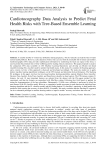
Cardiotocography Data Analysis to Predict Fetal Health Risks with Tree-Based Ensemble Learning
Статья научная
A sizeable number of women face difficulties during pregnancy, which eventually can lead the fetus towards serious health problems. However, early detection of these risks can save both the invaluable life of infants and mothers. Cardiotocography (CTG) data provides sophisticated information by monitoring the heart rate signal of the fetus, is used to predict the potential risks of fetal wellbeing and for making clinical conclusions. This paper proposed to analyze the antepartum CTG data (available on UCI Machine Learning Repository) and develop an efficient tree-based ensemble learning (EL) classifier model to predict fetal health status. In this study, EL considers the Stacking approach, and a concise overview of this approach is discussed and developed accordingly. The study also endeavors to apply distinct machine learning algorithmic techniques on the CTG dataset and determine their performances. The Stacking EL technique, in this paper, involves four tree-based machine learning algorithms, namely, Random Forest classifier, Decision Tree classifier, Extra Trees classifier, and Deep Forest classifier as base learners. The CTG dataset contains 21 features, but only 10 most important features are selected from the dataset with the Chi-square method for this experiment, and then the features are normalized with Min-Max scaling. Following that, Grid Search is applied for tuning the hyperparameters of the base algorithms. Subsequently, 10-folds cross validation is performed to select the meta learner of the EL classifier model. However, a comparative model assessment is made between the individual base learning algorithms and the EL classifier model; and the finding depicts EL classifiers’ superiority in fetal health risks prediction with securing the accuracy of about 96.05%. Eventually, this study concludes that the Stacking EL approach can be a substantial paradigm in machine learning studies to improve models’ accuracy and reduce the error rate.
Бесплатно
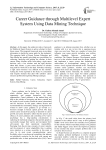
Career Guidance through Multilevel Expert System Using Data Mining Technique
Статья научная
In this paper, the author provides a framework for Multilevel Expert System to advice scholars for their future career. The proposed framework aims at providing information to decide the career paths for the academics. The emerging fields of Expert System, Education, and Data Mining are speedily providing new possibilities for collecting, analyzing and guiding the scholars in their careers. Many scholars suffer from taking a right career decision, only a few scholars took the right decision about their careers. A poor career decision of scholars may push his whole life in the dark. Nowadays selecting a right career becomes very difficult for the scholars. Among the works reported in this field, we concentrate only Experts Systems that deal with scholar's career selection problem through Data Mining technique.
Бесплатно
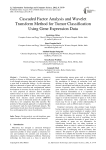
Статья научная
Correlation between gene expression profiles to disease or different developmental stages of a cell through microarray data and its analysis has been a great deal in molecular biology. As the microarray data have thousands of genes and very few sample, thus efficient feature extraction and computational method development is necessary for the analysis. In this paper we have proposed an effective feature extraction method based on factor analysis (FA) with discrete wavelet transform (DWT) to detect informative genes. Radial basis function neural network (RBFNN) classifier is used to efficiently predict the sample class which has a low complexity than other classifier. The potential of the proposed approach is evaluated through an exhaustive study by many benchmark datasets. The experimental results show that the proposed method can be a useful approach for cancer classification.
Бесплатно
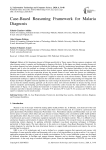
Case-Based Reasoning Framework for Malaria Diagnosis
Статья научная
Malaria is life threatening disease in Ethiopia specifically in Tigray region. Having common symptoms with other diseases makes it complex and challenging to diagnose effectively. In this paper case based reasoning framework for malaria diagnosis has been designed to diminish the challenges faced by inexperienced practitioners during malaria diagnosis and to solve the problem on shortage of health professionals. The required knowledge for this study was collected through interview and document analysis from domain experts, malaria patient history cards and other related relevant documents. In the case acquisition process the manual format of cases makes the process too challenging. Decision tree is used to model the acquired knowledge. The case structure was then constructed using the selected most determinant attributes. Machine learning approach is applied to select the most relevant features. Feature-vector case representation technique is applied to represent the collected malaria cases. Jcolibri programming tool integrated with Eclipse and Nearest Neighbor retrieval algorithm are used to design the framework. To the end based on the results we can say that the machine learning approach can be used to select most relevant attributes in diseases having several common symptoms and designing case-based diagnosis frameworks could overcome the main problems observed in health centers of Tigray. As an artifact the framework is evaluated by statistical analysis, comparative evaluation, user evaluation and other evaluation techniques. Averagely 79 % precision, 89 % recall, 91.4% accuracy and 78.8% domain expert’s evaluation was the results scored.
Бесплатно
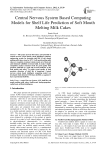
Статья научная
This paper presents the latency and potential of central nervous system based system intelligent computer engineering system for detecting shelf life of soft mouth melting milk cakes stored at 10o C. Soft mouth melting milk cakes are exquisite sweetmeat cuisine made out of heat and acid thickened solidified sweetened milk. In today’s highly competitive market consumers look for good quality food products. Shelf life is a good and accurate indicator to the food quality and safety. To achieve good quality of food products, detection of shelf life is important. Central nervous system based intelligent computing model was developed which detected 19.82 days shelf life, as against 21 days experimental shelf life.
Бесплатно
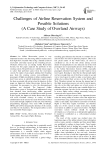
Challenges of Airline Reservation System and Possible Solutions (A Case Study of Overland Airways)
Статья научная
An Airline Reservation system is very important because it has the strong ability to reduce errors that might have occurred when using a manual system of reservation and helps speed up the boarding process. Overland Airways has an existing Airline Reservation System, but this paper analyzed the problems of the existing system. The problems are: inability of passengers to select their preferred seat(s) from the reservation system, No option of passengers printing their boarding pass from the existing system, non-notification of passengers of flight cancellation or delays and passengers don't have access to aircraft maintenance report to ease the fears associated with air travel and its disasters. In this paper, an Improved Airline Reservation System that is convenient for passengers to solve the aforementioned problems was designed. The Improved Airline Reservation system is designed and implemented using data obtained from interviewing airline personnel, passengers, and materials on Airline Reservation Systems. In this regard, the Improved Airline Reservation System will assist Overland Airways in variety of airline administration tasks and service needs from time of initial reservation through completion of the task. The following programming languages were used: PHP, JavaScript, HTML and CSS for designing the interface of the system, and SQL for the database. The designed airline system was tested with 50 passengers.
Бесплатно
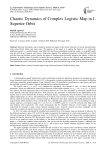
Chaotic Dynamics of Complex Logistic Map in I-Superior Orbit
Статья научная
Recently, the logistic map is studied to analyse the impact on the chaotic dynamics of various iterated logistic maps using Picard, Mann, and many more. The purpose of this paper is to explore the behavior of a multi-scale population model, i.e. modified logistic map (Mod-LM) and chosen population proportion model, i.e. extended logistic map (Ex-LM) in an I-superior orbit using a bifurcation diagram. The additional parameters of Mod-LM and Ex-LM with the three-step iteration system, increase the degree of freedom which invariably enhances the stability of both the functions. A detailed study of possible scenarios has been conducted to discover the effect of each parameter to the fixed point and its location, periodic cycle, and stability condition by examining the corresponding bifurcation diagram. The experimental result is discussed in terms of convergence point and chaotic range of the given dynamical systems.
Бесплатно

Chaotic Firefly Algorithm for Solving Definite Integral
Статья научная
In this paper, an Improved Firefly Algorithm with Chaos (IFCH) is presented for solving definite integral. The IFCH satisfies the question of parallel calculating numerical integration in engineering and those segmentation points are adaptive. Several numerical simulation results show that the algorithm offers an efficient way to calculate the numerical value of definite integrals, and has a high convergence rate, high accuracy and robustness.
Бесплатно
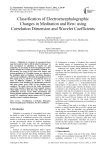
Статья научная
Meditation is a practice of concentrated focus upon the breath in order to still the mind. In this paper we have investigated an algorithm to classify rest and meditation, by processing of electroencephalogram (EEG) signals through the Wavelet and nonlinear methods. For this purpose, two types of EEG time series (before, and during meditation) of 25 healthy women are collected in the meditation clinic in Mashhad. Correlation dimension and Wavelet coefficients at the forth decomposition level of EEG signals in Fz, Cz and Pz are extracted and used as an input of different classifiers. In order to evaluate performance of the classifiers, the classification accuracies and mean square error (MSE) of the classifiers were examined. The results show that the Fisher discriminant and Parzen classifier trained on both composite features obtain higher accuracy than that of the others. The total classification accuracy of the Fisher discriminant and Parzen classifier applying Wavelet coefficients was 85.02% and 84.75%, respectively which is raised to 92.37% in both classifiers using Correlation dimensions.
Бесплатно
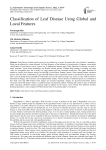
Classification of Leaf Disease Using Global and Local Features
Статья научная
Leaf disease of plants causes great loss in productivity of crops. So proper take care of plants is mandatory. Plants can be affected by various diseases. So Early diagnosis of leaf disease is a good practice. Computer vision-based classification of leaf disease can be a great way in diagnosing diseases early. Early detection of diseases can lead to better treatment. Vision based technology can identify disease quickly. Though deep learning is trending and using vastly for recognition task, but it needs very large dataset and also consumes much time. This paper introduced a method to classify leaf diseases using Gist and LBP (Local Binary Pattern) feature. These manual feature extraction process need less time. Combination of gist and LBP features shows significant result in classification of leaf diseases. Gist is used as global feature and LBP as local feature. Gist can describe an image very well as a scene. LBP is robust to illumination changes and occlusions and computationally simple. Various diseases of different plants are considered in this study. Gist and LBP features from images are extracted separately. Images are pre-processed before feature extraction. Then both feature matrix is combined using concatenation method. Training and testing is done on different plants separately. Different machine learning model is applied on the feature vector. Result from different machine learning algorithms is also compared. SVM performs better in classifying plant's leaf dataset.
Бесплатно
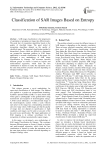
Classification of SAR Images Based on Entropy
Статья научная
SAR image classification is the progression of separating or grouping an image into different parts. The good feat of recognition algorithms based on the quality of classified image. The good recital of recognition algorithms depend on the quality of classified image. The proposed classification method is hierarchical: classes which are difficult to distinguish are grouped.An important problem in SAR image application is accurate classification. In this paper, we developed a new methodology of SAR image Classification by Entropy. The severance between different groups or classes is based on logistic and multi-nominal regression, which finds the best combination of features to make the separation and at the same time perform a feature selection depending on Grouped –Entropy value.
Бесплатно
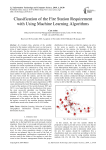
Classification of the fire station requirement with using machine learning algorithms
Статья научная
In crowded cities, selection of the suitable location for fire stations within the town is a vital issue in terms of rapid response to fires and minimizing loss of life and property. For the selection of the suitable fire station location, at first it is necessary to divide the whole city into certain zones and the need for a fire station service should be questioned for each zone. In this study, based on existing fire stations service area, classification of fire station requirement by zones was carried out using machine learning classification algorithms. In order to estimate fire station requirement according to the zones, a classification study was conducted by using some data such as the travel time of the fire engines to zone from closed fire stations, population density of the zone, the mean number of main and assistant vehicles travelling to the zone from closed fire stations, and the fire station existence data in the zone. The purpose of this study was to determine the most successful classification algorithm for the classification of the fire station requirement of 808 zones determined by Izmir Metropolitan Municipality. As a result of the analysis of fire records between 2015 and 2017, it was found that for the classification of the zones, the most successful algorithm was Random Forest algorithm with 93.84% accuracy rate. Experimental evaluation of the study; according to the 5-minute access distance of the existing fire stations, the fire station requirements of the regions and the fire station needs of the regions covered by the machine learning algorithm classification results were found to be 85.43% similar.
Бесплатно
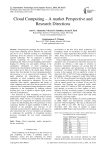
Cloud Computing – A market Perspective and Research Directions
Статья научная
Computational paradigm has been revolving round cloud computing and its offshoots for some time and till we see a breakout resulting in a breakthrough technology driven by advances in microelectronics and material technology. Till we experience a radically efficient technology for computation it is worth juxtaposing the virtues of cloud computing and market’s longing for offering cost and quality arbitrage to the marketplace. Integration of cloud computing in enterprises has the potential to influence the way business gets carried out by them in the market place. Different reports show that demand for cloud computing products and processes is in an upward growth trajectory. This paper identified the characteristics, drivers and constraints of cloud computing which influence its adaptation and integration in enterprises. We are also examining India specific opportunities and threats of cloud computing tools and cloud driven practices in the context of fierce competition among enterprises to remain competitive in the marketplace by reducing software licensing fees, cost of capital to acquire digital systems and cost of maintenances. New directions in cloud computing are analyzed by using Gartner strategic technologies and trend in research publications. Paper focuses on exploring the research issues which are categorized into technical and business in nature for understanding the evolving fortunes of cloud computing. Number of papers published in IEEE is an indication of the popularity and relevance of the continued research initiatives happening in the area. It is also noticed that that very few researchers are attempting to understand the possibility of remodeling business processes leveraging the new found computational paradigm.
Бесплатно
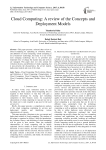
Cloud Computing: A review of the Concepts and Deployment Models
Статья научная
This paper presents a selected short review on Cloud Computing by explaining its evolution, history, and definition of cloud computing. Cloud computing is not a brand-new technology, but today it is one of the most emerging technology due to its powerful and important force of change the manner data and services are managed. This paper does not only contain the evolution, history, and definition of cloud computing, but it also presents the characteristics, the service models, deployment models and roots of the cloud.
Бесплатно
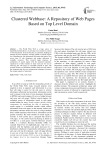
Clustered Webbase: A Repository of Web Pages Based on Top Level Domain
Статья научная
The World Wide Web is a huge source of hyperlinked information; it is growing every moment in context of web documents. So it has become an enormous challenge to manage the local repository (storage module of search engine) for to handling the web documents efficiently that leads to less access time of web documents and proper utilization of available resources. This research paper proposes an architecture of search engine with the clustered repository, organized in a better manner to make task easy for user to retrieving the web pages in reasonable amount of time. The research focuses on coordinator module which not only indexes the documents but also uses compression technique to increase the storage capacity of repository.
Бесплатно
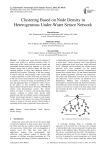
Clustering Based on Node Density in Heterogeneous Under-Water Sensor Network
Статья научная
An underwater sensor network comprise of sensors and vehicles to perform numerous tasks. In underwater ad-hoc sensor network acoustic signals are transmitted through multi-hop sequence so as to save sensors’ energy and to achieve longer life time. Re-charging batteries of deep water deployed sensors is practically not feasible. Clustering is the best strategy to achieve efficient multi-hopping, where cluster head is made responsible to collect local data and forward it to the sink. Cluster-head selection is the challenging job in a cluster, as it loses its energy in transmitting its own data and aggregated data, as compared to other sensors. In this paper we have proposed an Under Water Density Based Clustered Sensor Network (UWDBCSN) scheme using heterogeneous sensors. The scheme utilizes two types of sensors: one having high energy capacity, working as cluster head, having small quantity and other are ordinary sensors in huge quantity. Further cluster-head selection is based on node degree i.e. the density of the sensors in a region. The proposed scheme is found to be more energy efficient helps in extending the life time of underwater sensor networks.
Бесплатно
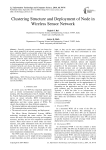
Clustering Structure and Deployment of Node in Wireless Sensor Network
Статья научная
Generally, grouping sensor nodes into clusters has been widely adopted by the research community to satisfy the above scalability objective and generally achieve high energy efficiency and prolong network lifetime in large scale WSN environments. The corresponding hierarchical routing and data gathering protocols imply cluster based organization of the sensor nodes in order that data fusion and aggregation are possible, thus leading to significant energy savings. We propose a clustering approach which organizes the whole network into a connected hierarchy and discuss the design rationale of the different clustering approaches and design principles. Further, we propose several key issues that affect the practical deployment of clustering techniques in wireless sensor network applications.
Бесплатно
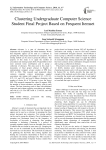
Clustering Undergraduate Computer Science Student Final Project Based on Frequent Itemset
Статья научная
Abstract is a part of document has an important role in explaining the whole document. Words that frequently appear can be used as a reference in grouping the final project document into categories. Text mining method can be used to group the abstracts. The purpose of this study is to apply the method of association rule mining namely ECLAT algorithm to find most common terms combination and to group a collection of abstracts. The data used in this study is documents of final project abstract in English of undergraduate computer science student of IPB from 2012 to 2014. This research used stopwords about common computer science terminology, applied association rule mining with support of 0.1, 0.15, 0.2, 0.25, 0.3, and 0.35, and used k-Means clustering with number of cluster (k) of 10 because it gives the lowest SSE. This research compared the value of support, SSE, the number of cluster members, and purity value in each cluster. The best clustering result is data with additional stopwords and without applying association rule mining, and with k is 10. The SSE result is 23 485.03, and with purity of 0.512
Бесплатно

